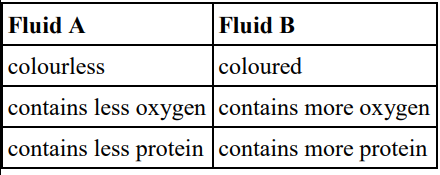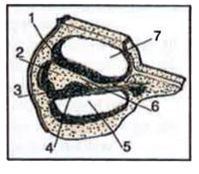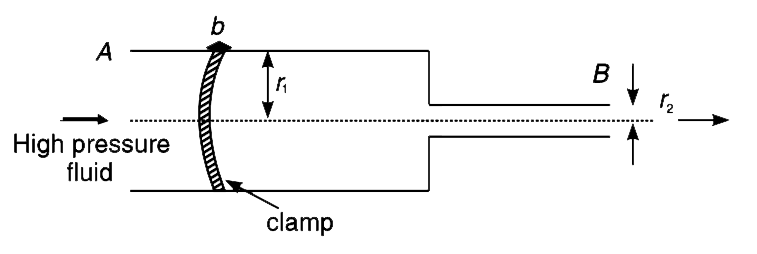Given below is a table representing the characteristics of two fluids involved in the transportation of substances in the human body.

(a) Identify fluid A and fluid B.
(b) With the help of a flow chart, describe the movement of fluid A from the intercellular spaces to the main circulatory system.
(c) What role does fluid A play in the digestion of food in humans?
Step by step video & image solution for Given below is a table representing the characteristics of two fluids involved in the transportation of substances in the human body. (a) Identify fluid A and fluid B. (b) With the help of a flow chart, describe the movement of fluid A from the intercellular spaces to the main circulatory system. (c) What role does fluid A play in the digestion of food in humans? by Biology experts to help you in doubts & scoring excellent marks in Class 10 exams.
Topper's Solved these Questions
Similar Questions
Name the watery fluid secreted by Brunner's gland in the duodenum. Mention its any two characteristics. What role does it play inside the duodenum ?
View SolutionIdentify the given diagram with its location in human body.
(b) Label no. (2). Name the fluid present in it.
(c ) Label nos. (3), (4) and (6). How they help in the functioning of the above diagram?
 View Solution
View Solution
Knowledge Check
- Question 1 - Select One
Given below are some of the process which takes place in our ear when we are exposed to any sound. Arrange these in the correct order of sequence.
(a)The eardrum vibrates the transmits the sound wave to the ear ossicles.
(b) Vibration travel from oval window to the fluid of cochlea.
(c) Ripples in the basilar membrane band the hair cell against the tectorial membrane
(d) Generation of waves in the lymphs.
(e ) sound waves are collected
by the pinna.
(f) generation of nerve impulse and transmission through auditory nerves to the brainAe,b,a,f,c,dBe,a,b,d,c,fCe,a,b,d,c,fDe,b,d,c,f,a - Question 2 - Select One
Read the following passage carefully and answer the questions given below it. Certain words/phrases are printed in bold to help you to locate them while answering some of the questions.
There is no field of human endeavour that has been so misunderstand as health. While health which connotes wellbeing and the absence of illness has a low profile, it is illness representing the failure of health which virtually monopolizes attention because of the fear of pain, disability and death. Even Sushruta has warned that this provides the medical practitioner power over the patient which could be misused.Till recently, patients had implicit faith in their physician whom they loved and respected, not only for his knowledge but also in the total belief that practitioners of this noble profession, guided by ethics, always placed the patient's interest above all other considerations. This rich interpersonal relationship between the physician, patient and family has, barring a few exceptions, prevailed till the recent past, for caring was considered as important as curing. Our indigenous systems of medicine like ayurveda and yoga have been more concerned with the promotion of the health of both the body and mind and with maintaining a harmonious relationship not just with fellow beings but with nature itself, of which man is an integral part. Healthy practices like cleanliness, proper diet, exercise and meditation are part of our culture which sustains people even in the prevailing conditions of poverty in rural India and in the unhygienic urban slums.These systems consider disease as an aberration resulting from disturbance of the equilibrium of health, which must be corrected by gentle restoration of this balance through proper diet, medicines and the establishment of mental peace. They also teach the graceful acceptance of old age with its infirmities resulting from the normal degenerative process as well as of death which is inevitable.This is in marked contrast to the western concept of life as a constant struggle against disease, ageing and death which must be fought and conquered with the knowledge and technology derived from their science a science which, with its narrow dissective and quantifying approach, has provided us the understanding of the microbial causes of communicable diseases and provided highly effective technology for their prevention, treatment and control. This can rightly be claimed as the greatest contribution of western medicine and justifiably termed as 'high' technology. And yet the contribution of this science in the field of non-communicable diseases is remarkably poor despite the fur greater inputs in research and treatment for the problems of ageing like cancer, heart diseases, paralytic strokes and arthritis which are the major problems of affluent societies today,
Why does the author describe the contributions of science as remarkably poor?AIt concentrates more on health than on illness.BIt suggests remedies for the poor people.CIt demands more inputs in terms of research and technology.DNone of these - Question 3 - Select One
Fill in the blanks:
a. Simple organisms like sponges and coelenterates circulate …1… from their surroundings through their body cavities of facilitate the cells to exchange of O2,CO2, nutrients and waste products.
b. More complex organisms used special fluids within their bodies to transport such materials. The ...2... is most commonly used body fluid by most of the higher organisms including humans for this purpose.
c. Another body fluid ...3... also helps in the transport of certain substances.A1-lymph, 2-water, 3-bloodB3-lymph, 1-water, 2-bloodC2-lymph, 3-water, 1-bloodD2-lymph, 1-water, 3-blood
In a machine, a fluid from a compressor, which is at high pressure, is allowed to pass through a nozzle. Cross section of the nozzle is shown in the fiuge. The nozzle consists of two sections of radii r1 and r2. The nozzle is fixed on a stand with the help of a clamp. the clamp is a circular ring of radius r1 and width b. The fluid from the compressor is at a presssure of n times the atmospheric pressure p0. assume that the entrie system is horizontal the fluid is ideal and the flow is steady.

(a) what should be the volume flow rate so that pressure of the fluid at end B reduces to half of its value at end A?
(b) If the entire system is kept in gravity free space and the net force on the nozzle due to the fluid flow is F then determine the minimum radial pressure that should be applied on the clamp. so the nozzle remains in place. Coefficient of friction betwwen clamp and nozzle is μ.
(c) If a small hole is punched anywhere on the thinner part of the nozzle (close to end B) what should be the volume flow rate of the fluid so that it does not gush out?View SolutionThe word fluid means a substance having particles which readily of its magnitude (a small shear stress, which may appear to be of negligible will cause deformation in the fluid). Fluids are charactrised by such properties as density. Specific weight, specific gravity, viscosity etc. Density of a substance is defined as mass per unit volume and it is denoted by. The specific gravity represents a numerical ratio of two densities, and water is commonly taken as a reference substance. Specific gravity of a substance in written as the ratio of density of substance to the density of water. Specific weight represents the force exerted by gravity on a unit volume of fluid. It is related to the density as the product of density of a fluid and acceleration due to gravity. Viscosity is the most important and is recognized as the only single property which influences the fluid motion to a great extent. The viscosity is the property by virtue of which a fluid offers resistance to deformation under the influenece if shear force. The force between the layers opposing relative motion between them are known as forces of viscosity. When a boat moves slowly on the river remains at rest. Velocities of different layers are different. Let v be the velocity of the level at a distance y from the bed and V+dv be the velocity at a distance y+dy. The velocity differs by dv in going through a distance by perpendicular to it. The quantity dvdy is called velocity gradient. The force of viscosity between two layers of a fluid is proportional to velocity gradient and Area of the layer.
F∝A & F∝dvdy
F=−ηAdvdy (−ve sign shown the force is frictional in nature and opposes relative motion. η coefficient of dynamic viscosity
Shear stress FA=−ηdvdy
and simultaneously kinematic viscosity is defined as the dynamic viscosity divided by the density. If is denoted as v. The viscosity of a fluid depends upon its intermolecular structure. In gases, the molecules are widely spaced resulting in a negligible intermolecular cohesion, while in liquids the molecules being very close to each other, the cohesion is much larger with the increases of temperature, the cohesive force decreases rapidly resulting in the decreases of viscosity. In case of gases, the viscosity is mainly due to transfer of molecular momentum in the transerve direction brought about by the molecular agitation. Molecular agitation increases with rise in temperature. Thus we conclude that viscosity of a fluid may thus be considered to be composed of two parts, first due to intermolecuar cohesion and second due to transfer of molecular momentum.
If the velocity profile is given by
v=23y−y2v is velocity in m/secy is in meter above the bad. Determine shear stress at y=0.15m, & η=0.863Ns/m2View Solution(a) What is blood ? Why is it red ?
(b) State the functions of blood in our body.
(c) Name a circulatory fluid in the human body other than blood.View SolutionWhat are fluids ? Name two common fluids.
(b) State Archimedes' principle.
( c) When does an object float or sink when placed on the surface of a liquid?View SolutionWhich of these statements are fasle regarding the human respiratory regarding the human respiratory system ?
(a) The nasal chamber opens into the pharynx .
(b) Trachea, bronchus and initial bronchioles are supproted by complete cartilaginous rings.
(c ) The branching network of bronchi, bronchioles and alveoli comprises the lungs.
(d) Pleural fluid increase friction on the lung surface.View Solution
